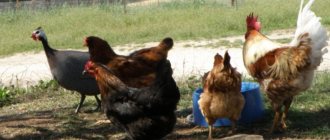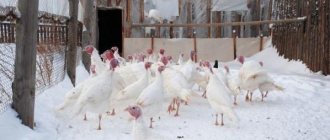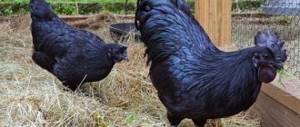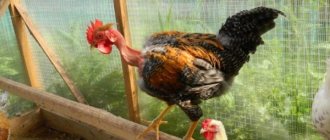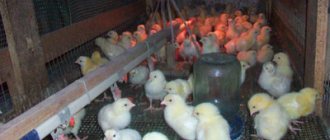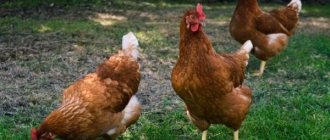Find out whether it is permissible to house laying hens and broilers with other farm birds or animals. For example, is it possible to keep chickens and turkeys together? Ideally, all pets should have their own “living area”, where special conditions are met. But in reality it is not always possible to fulfill this requirement. In the article we will tell you with whom it is allowed and with whom it is forbidden to share chickens. And how to make “cohabitation” comfortable for any living creature.
Will adult hens get along with chicks?
Problems
Often, due to lack of free space, owners try to place laying hens or broilers of different ages together. This doesn't always end well.
If there is a large age difference between birds, conflicts are possible. In addition, they need different feeds, temperatures, and conditions.
There are cases where older chickens pecked young animals. Or they took food from the chickens. In addition, chicks have weak immunity. They easily contract diseases from adult chickens.
Solutions
There are several ways to solve the problem.
The optimal age difference for keeping chickens together is 20-25 days. Since they need approximately the same conditions.
There is a trick: place chickens of different ages in the same house. But divide it with a grid. This way the birds will see each other, but will not be able to fight. Gradually they will get used to their neighbors.
If you nevertheless decide to immediately combine the young and the “old ones”, it is better to place the latter with the chicks, and not vice versa. And do it after sunset, in the dark. So that the chickens do not immediately see each other.
Chicks up to 10 days old are definitely kept separately. Because they need a regimen and special nutrition.
If egg laying has stopped
It may happen that after moving into the chicken coop, the quails stopped laying eggs. There can be two explanations for this: incorrect temperature conditions and chickens. To monitor the temperature during the cold season, install a thermometer in the chicken coop. In cold winters, you need to make sure that the room does not cool too much.
Cold can not only cause the cessation of egg laying, but also a cold in quails.
Some poultry farmers note that with good lighting, quails continue to lay eggs even at a fairly low temperature of 5–7 degrees below 0. However, air humidity differs in different regions, so it is better to insulate the room. The second reason may be the theft of chickens, which can drink quail eggs rolling out of the cage. In this case, you should simply close the trays. All conditions should be taken into account together - the birds should be comfortable in the room.
Birds of different breeds and directions
Basic details of check-in
Farmers often practice keeping different types of chickens in the same room. Whether it will be successful depends on various factors.
Until the age of two months, birds of different breeds and directions live together without quarrels. Then there is the issue of growth and diet.
Larger breeds often suppress their miniature counterparts. Even if they belong to the same direction. For this reason, it is better to house small and large chickens of different breeds.
Other points
It is not recommended to combine chickens of different breeds if they have a different purpose. When some go for meat, others lay eggs.
Broilers and laying hens have different diets. The first ones are given a lot of protein food so that they gain weight. This diet is contraindicated for egg hens. It causes obesity and will have a bad effect on productivity.
The amount of food required for meat breeds and laying hens is also different. When birds live together, it is difficult to control which of them consumes how much. Some may overeat. And others suffer from lack of food.
In addition, laying hens are more active than meat birds. Because of this, the neighborhood is uncomfortable for the latter. If you absolutely need to place representatives of different directions together, divide the space with a grid or a solid partition.
Will cockerels of different breeds fight?
Roosters naturally have a sense of territory and compete with each other. Therefore, keeping them together is problematic.
Cockerels of different ages do not tolerate proximity well. The elders are hostile towards the young and may even peck at them.
You should not keep together ordinary roosters and birds with tufts and thick feathers on their legs. Such “decorations” provoke fellow dogs of other breeds.
We have already said that representatives of egg breeds are more active and mobile than their meat counterparts. This is true for roosters too. The first ones like to start fights.
The nature of a particular breed must also be taken into account. There are calm birds, for example, Cochins. The roosters are behaving peacefully. They are often offended by representatives of other, even small breeds.
Learn more on the topic in the article “What to do if roosters are constantly fighting.”
Benefits of different bird species living together
People think about keeping other animals together with chickens when they want to increase their livestock. But there is not enough space. There are advantages and disadvantages to shared occupancy.
The first advantage is the opportunity to save money. After all, you don’t have to equip a separate room for the birds. The second is less time for cleaning, replacing bedding, cleaning feeders and drinkers. Finally, with proper organization of space, you will get the maximum product from a minimum area.
But remember that different animals have different needs for food, humidity, light, temperature, and physical activity. When placing several species of birds in one house at the same time, take into account the characteristics of each.
Chickens in the same enclosure with turkeys
There are more cons
Chickens and turkeys don't get along very well. The reason is that each species of birds needs its own conditions for a comfortable existence.
Among the advantages of living together, we can only note the saving of space and time for cleaning. Otherwise, the cons outweigh the cons. These birds have:
- different feed needs;
- activity and need for space differ;
- incompatible characters;
- there is a danger of transmitting deadly infections.
What else needs to be taken into account
Turkeys grow quickly. Therefore, chickens and turkey poults cannot be kept together. The latter will literally trample their neighbors.
They also need different temperatures for full development: for turkey poults 35 degrees, for chickens 30.
The turkey seeks to establish rules in the territory. Therefore, conflicts with chickens are inevitable. And both sides will suffer.
Turkeys also often sit in chicken nests and crush the eggs lying there.
The turkey, especially as it grows, is sensitive to drafts and the sanitary condition of the poultry house. And a diet that is significantly different from chicken.
He also needs 11 to 13 hours of daylight. Chickens need more light - 14 hours. Especially for laying hens, whose productivity decreases when there is a lack of lighting.
Why the neighborhood is dangerous: bird diseases
If you keep turkeys together with other birds, the risk of epidemics on the farm increases many times over. Since turkeys are sensitive to many infections due to the increased acidity of the body (pH). It allows microbes to develop quickly.
When kept with chickens, turkeys become ill with histomoniasis, receiving the pathogen from their neighbors. Chickens get it much less often. They also infect turkeys with heterakis parasites. They are harmless to chickens but lethal to turkeys.
Turkeys' excrement contains bacteria that are dangerous to chickens. And since these birds love to rake garbage and dig in the ground, they easily become infected. The greatest danger is infectious typhus. It is capable of completely destroying the chicken population.
Who is better to breed?
In terms of nutrition, quail eggs , since they will not cause health problems even when consumed raw. A person will not be able to become infected with salmonella, which can be caught from an ordinary chicken egg, since the body of a quail reaches 42 degrees, thereby creating a barrier against infection.
For beginners, it is more suitable to work with chickens than quails, since they are lighter and do not require an incubator for the birth of offspring. They are more popular on sale due to their lower cost.
AnimalsComment
How to properly house chickens with ducks and turkeys
Flaws
Ideally, it is not recommended to keep chickens and ducks together. These are different species, one of which is a waterfowl. Ducks need high humidity, chickens need dryness. The former need a body of water vitally, the latter have no use for it.
If you place ducks with other birds, they will breed dampness. This will lead to diseases in land-based neighbors, slower growth, and decreased egg production. In addition, ducks are voracious; they take food from chickens. In this case, the diet of these two birds should be different.
What can be done
If it is impossible to house chickens and ducks, the premises need to be zoned.
Ducks are provided with a place to swim or access to a pond. Kuram is a container with ash in which they dry feathers and clean them of parasites. Read about the importance of this point in the article “How to get rid of feather eaters in chickens.”
To keep birds together, consider the need for light. Chickens need more of it. Provide good ventilation in the chicken coop.
Ducklings can be kept even with day-old chicks. However, organize feeding separately. Chickens scoop up food and ducklings slosh around in the water. So they interfere with each other.
It's easier with Indians. They need less moisture and do not need much water.
However, when settling chickens and turkey ducks, remember that in general the rules for “cohabitation” with them are the same as with other waterfowl.
Difficult neighborhood with geese
We figured out whether it is possible to keep chickens and ducks in the same house. Now about the geese.
Geese are also waterfowl. This means the difficulties with them are the same as with ducks.
There is one big drawback - geese are also aggressive. They are capable of literally terrorizing smaller neighbors. Naturally, this has a bad effect on the growth and development of broilers and the egg production of laying hens.
Conflicts and stress even lead to the death of chickens. Plus, the high humidity required by geese has a negative impact on chicken health.
The only advantage of keeping chickens and geese together is saving space.
Only the joint walking of these birds goes relatively well. And that is provided that the territory is vast. And the grazing zones are separated.
Quails
In ancient times, quails were hunted, later they were domesticated, and as a result, keeping these animals allowed their owners to acquire certain advantages. Their breeding is most beneficial for those who like to eat poultry every day .
In size, they are much smaller than chickens, and when breeding, it should be taken into account that they will have to be kept more so that there is enough meat. This minus is compensated by the fact that their meat is healthier compared to chicken and is considered more tasty.
The benefits of breeding quails do not end there. Their eggs contain several times more vitamins than chicken eggs and surpass them in potassium, iron and phosphorus content. As a rule, they are consumed raw; they lower blood cholesterol levels due to their lecithin content.
Quails begin to lay eggs faster than chickens due to their rapid growth. The first eggs can be obtained within 6 weeks after the bird matures . As a rule, the purpose of their breeding is to obtain healthy eggs and dietary meat. They are convenient to house in a small area. It is worth knowing that they fly well and can overcome large obstacles, so they should be covered with a net.
The main features of quail breeding:
- They do not occupy a large area when breeding.
- Healthy meat and eggs.
- Uncomplicated conditions of detention.
- They have strong immunity to diseases.
- The most convenient cell breeding method.
Quails and chickens on the same living space
Content Rules
When quails and chickens are kept in the same room, they do not roam freely. Quails live in cages that are placed in a chicken coop.
The positive thing is that these birds have similar climate requirements. They love warmth and dryness. At the same time, quail needs a temperature of at least 10 degrees.
To maintain the temperature, the room is insulated for the winter. To do this, make a deep litter of peat, straw or sawdust.
The walls are covered with glass wool, foam plastic with a vapor barrier film. Or homemade insulation made from lime mixed with pine needles or sawdust. Read more in the article “How to insulate a chicken coop for the winter with your own hands.”
Place quail cages in tiers, leaving no gap between them and the ceiling. Otherwise, the chickens will roost there and defecate on the roofs of the houses. And for quail, this is an extra source of moisture and bacteria.
Danger
For quail, proximity to chickens can be dangerous due to the presence of pathogens. These are mainly mites, parasites and viruses. They only create discomfort for chickens. And the quails are dying.
The second common cause of death in quail is hypothermia. In addition to the chicken coop, the cages also need to be insulated using insulating materials and lamps.
Breeding
Everything is clear about chickens - you need an individual that can hatch eggs until the offspring appear. Fortunately, these birds have not lost the ability to hatch, as happened with quails. You just need to find the right one and the young will hatch very soon. Usually, birds of the meat or meat-egg breed are taken for this purpose.
In addition to hatching, the “mother” will take care of the offspring when the chicks need to be nursed. In addition to the “natural” breeding method, you can use an incubator. This will be more difficult, but it will be a way out of the situation when the hen is not found.
There is no alternative for breeding quails. Only an incubator. In the process of evolution, they have lost the instinct to hatch, so immediately after the bird lays a fertilized egg, it is taken away and sent to an incubator. There, the embryos will develop into full-fledged chicks in a few weeks.
You can buy an incubator at a specialized store, or you can assemble it yourself. Guidance for this is available in agricultural literature or on the Internet, on websites dedicated to quail.
How to minimize negative factors
Correct arrangement
Add ducks, quails or turkeys to chickens from an early age. So that they get used to each other. At the same time, young animals need to be raised competently. Read about this in the article “On raising chickens at home: from daily allowance to a month.”
It is advisable to zone the territory for various types of birds with a net or wooden partitions, providing each pet with the necessary climate and proper nutrition.
Make nests for chickens higher. Other birds are more comfortable on the floor, in nests made of a large amount of hay and straw.
To prevent waterlogging in the house, install drinkers with nipples. Read about their advantages in the article “Types of nipple drinkers for chickens.”
Different birds will need separate feeders. Recommendations in our article “Making chicken feeders with your own hands.”
Important standards
Cleaning and disinfection of the premises should be carried out regularly. As well as veterinarian examinations, preventive measures to combat diseases.
Proper ventilation can help avoid many problems. This is discussed in detail in the article “How to properly ventilate a chicken coop.”
The walking yard should be spacious and zoned. So that every bird feels at ease. And she got enough food.
Caring for quails
Newly hatched quail are small and vulnerable, and the most important thing for them is warmth. They need additional high-quality heating during the first 3-4 weeks. At home, you can use a commercial brooder, an infrared lamp, or any other heat source that will provide adequate heating. The lamp is placed at a height of 30-46 cm from the floor.
Maintain the temperature at least 37 °C during the first week of keeping. These indicators are reduced by about 3.5 °C per week until the chickens are completely covered with feathers, then their normal temperature will be 19-20 °C.
The best indicator of temperature regulation is the behavior of the chicks. If the quail crowd under the lamp and appear frozen, this indicates that the temperature is too low. When the chicks want to move away from the heat source, the temperature is reduced by raising the lamp higher.
Failure to provide sufficient heat invariably leads to death. In addition, young animals must be protected from drafts and cold air, especially at night.
Care must be taken when watering quail to prevent them from drowning in water containers. Automatic small waterers are the best choice, but shallow bowls partially filled with pebbles or crushed stone can also be used.
Once babies are a week old, the drainage can be removed
For older quails, it is important to ensure constant access to clean water and the best quality option for this is nipple drinkers. Stationary water containers or troughs are cleaned and washed daily
Porous bedding is used to maintain cleanliness and absorb moisture. Wood shavings, sawdust or river sand are good materials. The litter is placed on the floor 5-10 cm thick and covered with several layers of paper during the first week. It is better to use soft sheets; hard, smooth paper is undesirable, as the chickens will slip and constantly lose their balance.
Old newspapers are a good, but not ideal material; paper towels are the best. If chickens are kept in cages with slatted floors, cover the surface with paper for the first week to ten days to prevent leg injury.
Placing quail on paper towels
Eating feathers and cannibalism of young animals are common problems when breeding quails at home. These disorders are especially common when kept in cells. A radical method of control is to trim the beak at the age of 2 weeks and is usually done using a special trimmer.
The end of the top of the beak can also be trimmed using nail clippers. After the procedure, the level of feed in the feeders and water in the gutters must be increased.
Other effective preventative measures for cannibalism are:
- reducing the number of birds to avoid overcrowding;
- reducing lighting intensity;
- increasing the content of fiber and protein components in feed.
Quails are a territorial bird, and will defend their home from intruders, establish a hierarchy and sometimes fights are inevitable. Ways to avoid this are to have a looser fit and reduce lighting. If it is necessary to combine two groups of quails, they are simultaneously placed in an unfamiliar cage or enclosure.
Incubation at home
Dear readers, write your review about raising quails at home. Remember that you can send a full story about the peculiarities of keeping and breeding poultry using our contact form, and your article will be published in one of these sections, Your Quails. If you are a breeder and sell young stock or eggs, you can include this information, but do not forget to indicate your region of residence and contact information.
